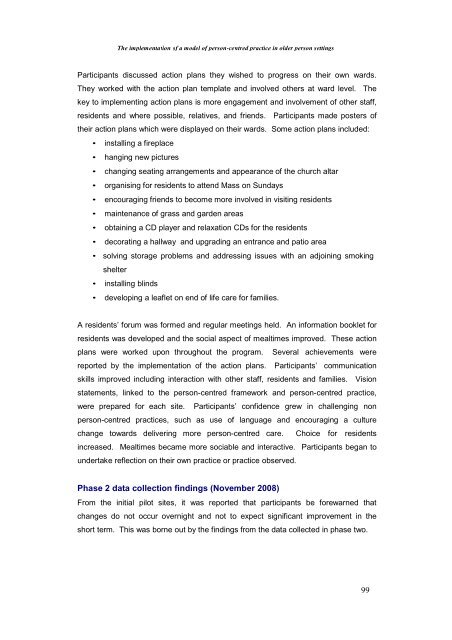The Implementation of a Model of Person-Centred Practice In Older ...
The Implementation of a Model of Person-Centred Practice In Older ...
The Implementation of a Model of Person-Centred Practice In Older ...
Create successful ePaper yourself
Turn your PDF publications into a flip-book with our unique Google optimized e-Paper software.
<strong>The</strong> implementation <strong>of</strong> a model <strong>of</strong> person-centred practice in older person settings<br />
Participants discussed action plans they wished to progress on their own wards.<br />
<strong>The</strong>y worked with the action plan template and involved others at ward level. <strong>The</strong><br />
key to implementing action plans is more engagement and involvement <strong>of</strong> other staff,<br />
residents and where possible, relatives, and friends. Participants made posters <strong>of</strong><br />
their action plans which were displayed on their wards. Some action plans included:<br />
• installing a fireplace<br />
• hanging new pictures<br />
• changing seating arrangements and appearance <strong>of</strong> the church altar<br />
• organising for residents to attend Mass on Sundays<br />
• encouraging friends to become more involved in visiting residents<br />
• maintenance <strong>of</strong> grass and garden areas<br />
• obtaining a CD player and relaxation CDs for the residents<br />
• decorating a hallway and upgrading an entrance and patio area<br />
• solving storage problems and addressing issues with an adjoining smoking<br />
shelter<br />
• installing blinds<br />
• developing a leaflet on end <strong>of</strong> life care for families.<br />
A residents’ forum was formed and regular meetings held. An information booklet for<br />
residents was developed and the social aspect <strong>of</strong> mealtimes improved. <strong>The</strong>se action<br />
plans were worked upon throughout the program. Several achievements were<br />
reported by the implementation <strong>of</strong> the action plans. Participants’ communication<br />
skills improved including interaction with other staff, residents and families. Vision<br />
statements, linked to the person-centred framework and person-centred practice,<br />
were prepared for each site. Participants’ confidence grew in challenging non<br />
person-centred practices, such as use <strong>of</strong> language and encouraging a culture<br />
change towards delivering more person-centred care. Choice for residents<br />
increased. Mealtimes became more sociable and interactive. Participants began to<br />
undertake reflection on their own practice or practice observed.<br />
Phase 2 data collection findings (November 2008)<br />
From the initial pilot sites, it was reported that participants be forewarned that<br />
changes do not occur overnight and not to expect significant improvement in the<br />
short term. This was borne out by the findings from the data collected in phase two.<br />
99
















